How to set the air conditioner for cold air? Power-up Guide for Switching to Cooling
How many times on hot days have you regretted the lack of air conditioning? And after the summer heat, they wanted to get into the coolness, and not into a stuffy room. And finally, the selected product at home is already installed. A new acquisition will change your life and make it more comfortable.
However, an air conditioner is not the simplest climate control equipment; you still need to figure it out. We will try to explain simply and clearly how it works, how to set the air conditioner for cold air and much more.
Here you will find detailed step-by-step instructions for transferring the operation of the climate system from one operating mode to another. Our tips will help you create an ideal microclimate in the room being treated. By following our recommendations, you will prevent breakdowns and premature wear of equipment.
The content of the article:
Functionality of air conditioners
Air conditioners have long been part of our daily lives and have become as commonplace as an iron, refrigerator or washing machine.
Being one of the most popular and sought-after types of climate control equipment, which is designed to create more comfortable and favorable living conditions, the device is widely used in private homes and city apartments, in offices and cars.
Depending on the functionality, professionals distinguish between split systems that perform:
- cooling only;
- temperature reduction and heating;
- service at low and high temperatures;
- special abilities.
The last point combines aromatization and humidification, ionization, additional air purification and other functions. In addition to the coarse filter, which is found in all units without exception, additional filters are also produced that provide fine cleaning.
Bio and carbon filters, ultraviolet and electrostatic, depending on the filter element, destroy not only microscopic particles of dirt and pollen, but also viruses, bacteria and fungal spores.
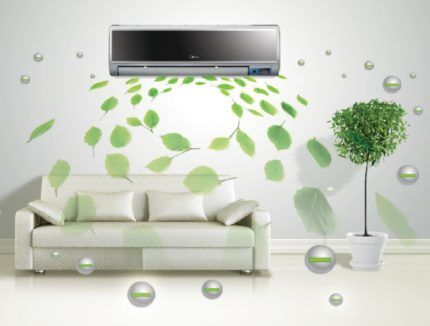
However, in addition to medical recommendations for the use of ionized air mass for allergies or asthma, there are categorical prohibitions for patients prone to oncology, pneumonia or heart attack. Therefore, this function should be used carefully, especially in dirty rooms.
The ionization process can also be considered with additional fine filtration. The ionizer is placed in the housing of the indoor unit, where negative ions are formed after the decay of water vapor.
Spreading throughout the room, they have an antibacterial effect, eliminate tobacco smoke and other unpleasant odors (cleansing from tobacco smoke will take 5-10 minutes, from bacteria - about three hours).
The process of humidifying indoor air can occur either by simply using a steam generator or placing a humidifying component in the outdoor unit, or by using ultrasound.
The principle of operation of the cooling system
All air conditioners and split systems differ in power, design and installation principle, price and manufacturer.However, each operates according to the same circuit and consists of two radiators, an evaporator and a condenser, a compressor and a valve.
Between them, moving through copper tubes, freon with compressor oil circulates in a circle. The principle by which all existing air conditioners operate is based on the properties of liquids: during evaporation, heat is absorbed, and during condensation, it is released.
Freon is used as a liquid with a low boiling point.
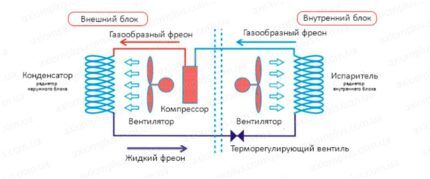
The main signs of a leak are: decreased efficiency, freezing of the outdoor unit valves and oily smudges.
From the evaporator indoor unit freon gas enters an external compressor through copper tubes, which raises the pressure and temperature (from 15 to 80 degrees). It then enters the condenser where it is cooled. Then releasing the heat absorbed in the room, it turns into a liquid state.
Freon moves into the evaporator through a thermostatic capillary and, returning to the gaseous stage, takes away heat. Thus, the air passing through the evaporator cools down, and the room receives long-awaited coolness.
In cold-heat air conditioners, the reverse process occurs; freon (due to the presence of a special valve) moves in the opposite direction. In such a situation, the indoor unit heats the air, and the outside cools.
Remote control keys and functions
The mode of cooling the air in the room is a key task; it is usually why an air conditioner is purchased.The split system is controlled using commands issued from a microcircuit unit in the remote control. Different manufacturers produce a large number of various remote controls, but despite the design, the buttons and functions remain unchanged.
As practice shows, the majority of consumers use only a few necessary keys to change:
- operating mode (Mode);
- temperature (Temp);
- fan speed (Fan);
- blinds position (Swing).
Nevertheless, well-known manufacturing companies are trying to beat their competitors and add new features, some of which have already won their audience. For example, in the event of a malfunction, the air conditioner signals an inscription (the “self-diagnosis” function); in the case of an empty room, the device turns on the sleep mode (“motion sensor”), as well as ionization, anti-allergenic air purification and the Wi-fi function.
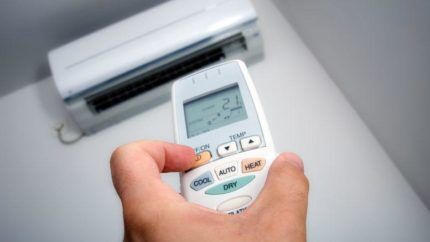
Remote controls are available in wired and infrared versions, the former are used to control semi-industrial and industrial units, the latter are used for conventional household air conditioners.
One wired remote control via microcable can configure from 4 to 8 settings. A simple remote control is produced according to commercial samples, but if necessary, you can purchase a universal remote control and use a code to activate and control any model.
The developers strive to simplify the symbols on the buttons so that any user can understand the functions of the air conditioner: a snowflake indicates a decrease in temperature, the sun means heating, an asterisk means sleep mode, a clock means a timer, etc.
The remote control controls the parameters and modes of the air conditioner and corrects the direction of air masses. If brightness and response speed decrease, both batteries should be replaced.The distance between the remote control and the internal unit of the device should not exceed 8 meters.
The process of turning on cold air
All household devices, including climate control ones, are constantly being improved and modernized. Even the most ordinary average air conditioner has a considerable set of different modes, but the main one is cooling.
Almost every consumer, after purchasing a device, has encountered problems setting up an air conditioner and questions about how to switch from heat to cold and vice versa. Only the correct setting and correctly set temperature will ensure the most efficient functioning of the system.
To turn on the air conditioner for cooling, you must follow several steps:
- connect the device to the network, plug it into the socket;
- click on “on/off”, the blinds open;
- switch the “mode” key several times until a snowflake or “mode” appearscool«;
- select the desired temperature value using the up and down arrows “temp”;
- If necessary, adjust the position of the blinds and the fan speed using the “far” and “swing” keys.
In a conventional air conditioner, after reaching the desired temperature, the outdoor unit stops functioning until the air warms up again.

IN inverter devices the compressor does not turn off, but slows down, thanks to small, unnoticeable temperature fluctuations, comfort is created and more accurate temperature parameters are provided.
Temperature Range Tips
To escape the heat in the summer, you turn on the split system for cooling.
At the same time, you must not forget about the basic rules so as not to make it a source of colds:
- the temperature difference between the room and the street should not exceed 3-5 degrees;
- It is advisable not to set a low temperature of 16-17 degrees;
- the temperature decrease should be carried out gradually;
- Avoid long stays in three-meter risk zones.
It is recommended to cool the room step by step, avoiding contrast changes and lowering the temperature by 2-3 degrees once every half hour. The maximum difference with external indicators in extreme heat is 7-10 degrees. If possible, set the values in a comfortable range of 20-24 degrees.

It would be appropriate to use different shaft or “pumping” speeds for uniform distribution of cooled air (in any modern model there are at least three options). It is worth considering that when you turn on the Fan and Turbo modes, the temperature on the air conditioner is set automatically and is not regulated.
Recommendations for using the split system
Climate control helps us out in the hot summer months, cools our apartments and houses, and in order to keep split systems in good condition and for a long time, it is wise to listen to the following recommendations.
Tip #1. When choosing an air conditioner, take seriously the calculation of the power of the required equipment.
When calculating, it is necessary to take into account the area of the room, the number of people living, the presence of heat-generating devices and other parameters, but the base value should be taken as a number equal to the area divided by ten.
In practice, the power consumption is three times less than the cooling power; in fact, an air conditioner is a refrigeration device that moves cold. For this reason, it is more economical to heat a room with an air conditioner rather than with electric heaters.
In any case, to effectively use a split system, you need to purchase an air conditioner with a power corresponding to the specified area of the room.
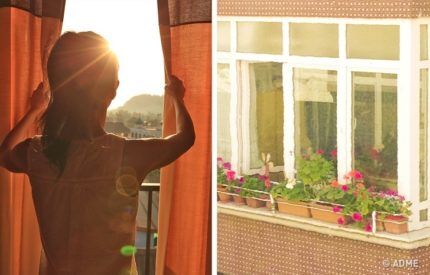
Tip #2. Do not place the air conditioner units on a sunny side. Under sunlight, the temperature sensor on the case will heat up and show values that do not correspond to reality. In addition, the air conditioner loses additional energy by neutralizing excess heat.
The optimal solution would be to use thick curtains or blinds in the apartment, and install visor for protection from the sun (in winter from snow) above the outdoor unit of the system.
Tip #3. Do not turn on the air conditioner for heating when the temperature is below zero.
All modern models have a limiting temperature range; for cooling it is from -5 and +18 degrees (for different systems) to the upper limit of +43.The limitation of use is due to changes in the physical characteristics of compressor oil and freon at subzero levels, and wear and tear of the compressor within 2-3 years.
Tip #4. Be sure to ventilate the room, but with the air conditioner turned off. It is a mistake to think that a conventional air conditioner cools the fresh air coming from the street, and pushes the used air out of the room outside. Only window and duct units have the ability to add fresh air to the total volume (up to 30%).
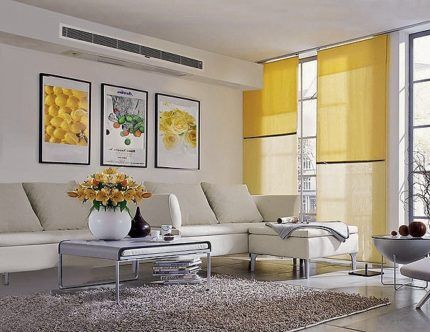
A split system can only cool and heat, and move the same air masses in a closed room in a circle. Typically, air conditioning is used with the windows and doors closed so as not to waste electricity, which, on the other hand, leads to the accumulation of carbon dioxide.
Therefore, it is necessary to ventilate the room for 15 minutes every few hours (with the air conditioner turned off).
Tip #5. Clean and change filters regularly. The accumulation of dust on the filters leads to the growth of bacteria and additional stress on the air conditioner. Modern models of devices are equipped with several filters for coarse and fine cleaning.
The main filter is designed to protect the parts of the indoor unit from dirt and prevent clogging of the system; the wear of the air conditioner as a whole depends on its quality. It is a metal or plastic mesh that can be easily washed with soapy water.
Fine filters are available in a wide range and are replaced by maintenance technicians.
Conclusions and useful video on the topic
In summer, freshness and coolness are important to us, but in winter we want warmth. A split system can help us:
If your air conditioner suddenly stops cooling the air, you may find this video useful:
As we can see, in order to enjoy cooled air, it is not enough to press a few buttons. To get coolness and comfort at home, and not a cold and malfunctioning of the device, you need to perform a whole range of tasks to install, configure and maintain the air conditioner.
If the information in the article was useful to you or gave rise to an interesting idea, share your ideas in the comments. Tell us about how you personally set up the air conditioner to supply cold air. In the block below you can ask a question and post photos.



